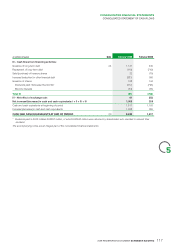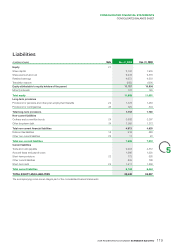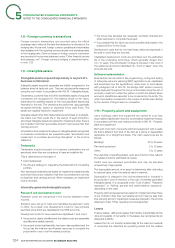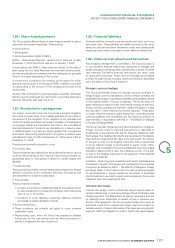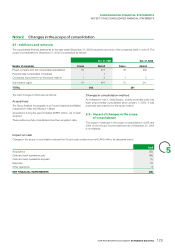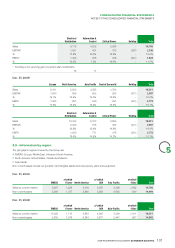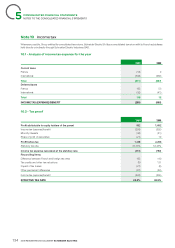APC 2009 Annual Report Download - page 129
Download and view the complete annual report
Please find page 129 of the 2009 APC annual report below. You can navigate through the pages in the report by either clicking on the pages listed below, or by using the keyword search tool below to find specific information within the annual report.
2009 REGISTRATION DOCUMENT SCHNEIDER ELECTRIC 127
CONSOLIDATED FINANCIAL STATEMENTS
5
NOTES TO THE CONSOLIDATED FINANCIAL STATEMENTS
1.20 - Share-based payments
The Group grants different types of share-based payment to senior
executives and certain employees. These include:
•stock options;
•stock grants;
•stock Appreciation Rights (“SARs”).
IFRS2 – Share-based Payment – applies only to plans set up after
November 7, 2002 that did not vest prior to January 1, 2005.
In accordance with IFRS2, these plans are valued on the date of
grant, using the Cox, Ross, Rubinstein binomial option pricing model,
and are recognised as an expense over the vesting period, generally
three or four years depending on the country.
A contra entry is posted to the treasury stock reserve for stock
grants and stock options. In the case of SARs, a liability is recorded
corresponding to the amount of the remeasured benefi t at the
closing date.
As part of its commitment to employee share ownership, Schneider
Electric gave its employees the opportunity to purchase shares at a
discount during the year (see note21.5).
1.21 - Provisions for contingencies
A provision is recorded when the Group has a present obligation
as a result of a past event, and a reliable estimate can be made of
the amount of the obligation. If the obligation is not probable and
cannot be reliably estimated, but remains possible, it is classifi ed as
a contingent liability and disclosed in the notes to the consolidated
fi nancial statements. Provisions are calculated on a case-by-case
or statistical basis. Long-term provisions (greater than one year) are
discounted. Discounting adjustments to long-term provisions were
calculated at a rate of 3.6% at December 31, 2009 versus 3.8% at
December 31, 2008.
Provisions are primarily set aside to cover:
•Economic risks.
These include tax risks arising from tax audits performed by various
local tax administrations and financial risks arising primarily on
guarantees given to third parties in relation to certain assets and
liabilities.
•Customer risks.
These provisions primarily concern liability claims arising from alleged
defects in products sold to customers and other third parties and
are determined on a case-by-case basis.
•Product risks.
These provisions comprise:
–provisions recorded on a statistical basis for the residual cost of
product warranties not covered by insurance. Such warranties
may run up to 18months,
–provisions to cover disputes concerning defective products
and recalls of clearly identifi ed products.
•Environmental risks.
•These provisions are primarily set aside to cover potential
reclamation costs.
•Restructuring costs, when the Group has prepared a detailed
formal plan for the restructuring and has either announced or
started to implement the plan at year-end.
1.22 - Financial liabilities
Financial liabilities primarily comprise bonds and short and long-
term bank debt. These liabilities are initially recorded at fair value,
taking into account any direct transaction costs, and subsequently
measured at amortised cost based on their effective interest rate.
1.23 - Financial instruments and derivatives
Risk hedging management is centralised . The Group’s policy is
to use derivative fi nancial instruments exclusively to manage and
hedge changes in exchange rates, interest rates or prices of certain
raw materials. Derivative financial instruments are never used
for speculative purposes. These risks are managed and hedged
primarily through the use of swaps, options and futures, depending
upon the nature of the Group’s exposure.
Foreign currency hedges
The Group periodically enters into foreign currency contracts to
hedge foreign currency transactions. Some of these contracts are
designated as hedges of operating receivables and payables carried
in the balance sheets of Group companies. The Group does not
apply hedge accounting to these instruments because at year-end,
foreign currency contracts are marked to market and gains or losses
are recorded in “Other fi nancial income and expense”. These gains
or losses offset the losses or gains arising from converting foreign
currency payables and receivables into the reporting currency at
year-end rates, in accordance with IAS21 – The Effects of Changes
in Foreign Exchange Rates.
The Group may also hedge recurring future transactions, intragroup
foreign currency loans or planned acquisitions or disposals of
investments. In accordance with IAS39, these are treated as cash
fl ow hedges. The hedging instruments are recognised in the balance
sheet and are measured at fair value at the period-end. The portion
of the gain or loss on the hedging instrument that is determined
to be an effective hedge is accumulated in equity, under “Other
reserves”, and recognised in the income statement when the hedged
transaction affects profi t or loss. The ineffective portion of the gain
or loss on the hedging instrument is recognised in “Other fi nancial
income and expense”.
In addition, certain long-term receivables and loans to subsidiaries are
considered to be part of the Group’s net investment in the companies
concerned, as defi ned by IAS21 – The Effects of Changes in Foreign
Exchange Rates. In accordance with the rules governing hedges
of net investments in foreign operations, the impact of exchange
rate fl uctuations is recorded in equity and recognised in the income
statement when the investment is sold.
Interest rate swaps
Interest rate swaps, which synthetically adjust interest rates on
certain indebtedness, involve the exchange of fi xed and fl oating-rate
interest payments. The differential to be paid (or received) is accrued
(or deferred) as an adjustment to interest income or expense over
the life of the agreement. The Group applies hedge accounting as
described in IAS39 for interest rate swaps. Gains and losses on
remeasurement of interest rate swaps at fair value are recognised in
equity (for cash fl ow hedges) or in profi t or loss (for fair value hedges).


